
Original Link: https://www.anandtech.com/show/2470
Olympus E-420: World's Smallest Digital SLR
by Wesley Fink on March 5, 2008 6:00 PM EST- Posted in
- Digital Camera
Every time a mention of the Olympus 4/3 camera system is made in articles we get comments that there is no promised size and weight savings with the 4/3 line. That ignores the E-410, which is currently the smallest DSLR made, but it is certainly true of the Pro-oriented E-3 whose construction and weather-sealing yield a solid camera that is both large and heavy. Perhaps to remind users that small is also beautiful, Olympus has just announced the world's smallest DSLR and a new 25mm f2.8 "pancake" lens that redefines small on a DSLR.
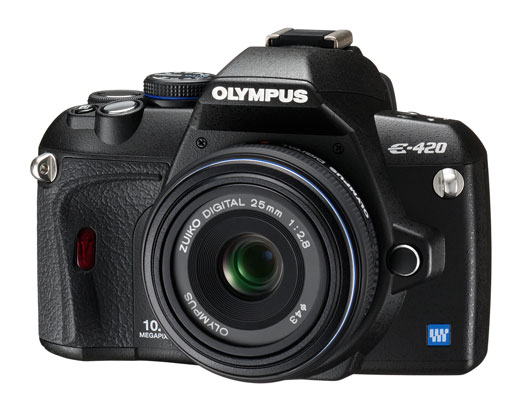
Olympus pioneered Live View, a feature that has become almost a checklist item for every new DSLR introduction these days. The Point-and-Shoot users who are migrating to DSLR in record numbers are used to this feature and many want to continue the ability to see and compose photos on the rear LCD. The E-420 takes Live View to a new level in the Olympus line, using both phase-detection and contrast-detection for focus on the 10MP (megapixel) Live View screen. Olympus says it also works just like regular AF (Auto-Focus) on the E-420: when you push the shutter release half-way you get AF on the rear LCD just like you do when looking through the optical viewfinder.
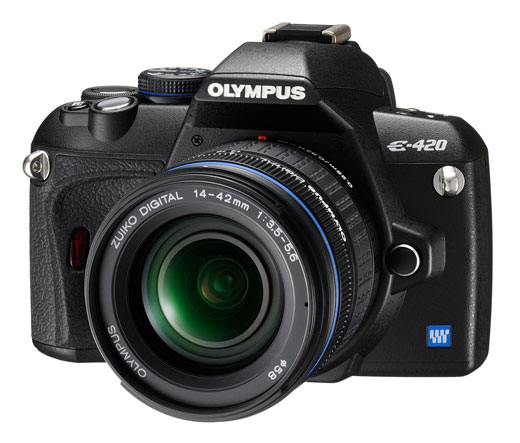
In addition, Olympus added another hot point-and-shoot technology to the E-420. Face Detection is this year's must have feature in P&S as we reported in our PMA coverage. The E-420 is the first DSLR with this feature and it promises to keep up to eight faces in focus in a picture. Despite the smaller camera size, the E-420 also increases the LCD size to 2.7" from the 2.5" of the E-410. Shadow Adjustment Technology also promises an expanded dynamic range.
Here's a quick rundown of the major features and innovations on the E-420:
- On-Screen Autofocus works as seamlessly as a point-and-shoot to display subjects in focus on the LCD the instant the shutter is pressed half way.
- Face Detection Technology targets and locks on up to eight faces to ensure they are in focus and crystal clear for amazing portraits.
- New and Improved HyperCrystal II Technology delivers twice the contrast and better viewing in extreme lighting conditions, a broader range of color detail, and a wider angle of view on the LCD so you and your friends can see it up to 176 degrees off-center.
- Shadow Adjustment Technology captures detail in the bright areas of a frame and opens up detail in the shadows that other cameras would render too dark or underexposed.
- Perfect Shot Preview enables you to view and select your favorite effect right on the LCD, and see how the image will look before you even capture it, so you know that what you see is what you get.
A Closer Look
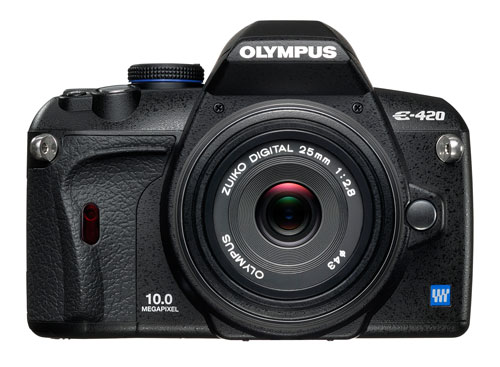
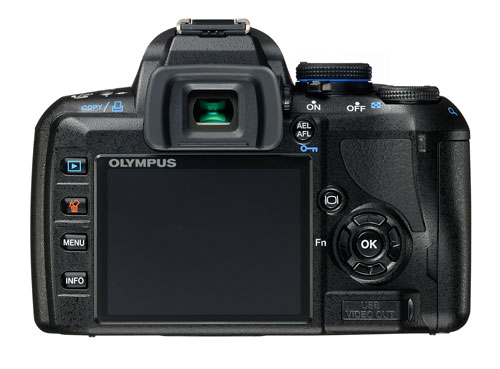
The trademark Olympus Supersonic Wave Filter automatic dust reduction system is also featured on the new camera. Every digital SLR produced by Olympus since the first E-1 appeared in 2003 has featured auto sensor cleaning. The E-420 supports wireless multi-flash with the FL-36R and FL-50R, which were recently introduced with the E-3. Olympus says the E-420 also features improved Auto White Balance, faster image processing, and lower noise with the updated TruePic III processor. Continuous shooting speed goes up to 3.5fps, which is fast compared to other entry-level cameras.
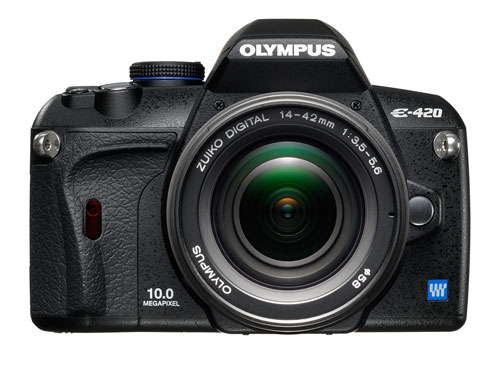
The E-420 is expected to ship in early May in several kit choices. We do not yet have the camera for testing, but Olympus has promised us a sample as soon as the E-420 is available. Estimated street prices are as follows:
- E-420 body : $499.99
- E-420 with ED 14-42mm f3.5/5.6 Zuiko Digital Zoom Lens: $599.99
- E-420 with ED 25mm f2.8 Zuiko Digital Lens: $699.99
E-420 Lenses
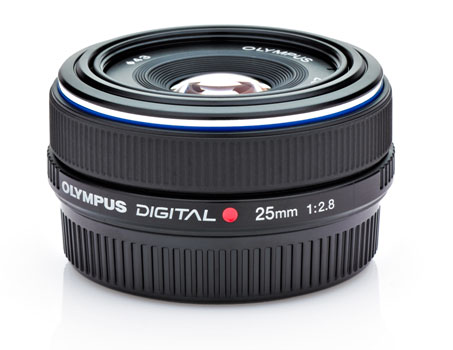
A new tiny 25mm f2.8 pancake lens will also launch with the E-420. The lens is very reminiscent of the pioneering Pentax 40mm f2.8. It is offered as a kit option for the E-420. The focal length of 25mm is the 35mm equivalent of 50mm on the 4/3 sensor since the lens factor is 2X, instead of the 1.6X/1.5X common with competing APS-C sensors.
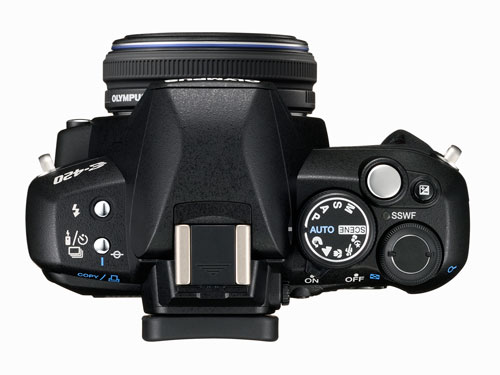
As you can see from this top view, the E-420 with the 25mm lens is truly small enough to fit in a small purse or a large pocket. The E-420 is also available with the 14-42mm (28-84mm equivalent, left below) zoom lens, which is the smallest and lightest kit zoom you can buy at 65.5mm diameter by 61mm length and a weight of 190g.








